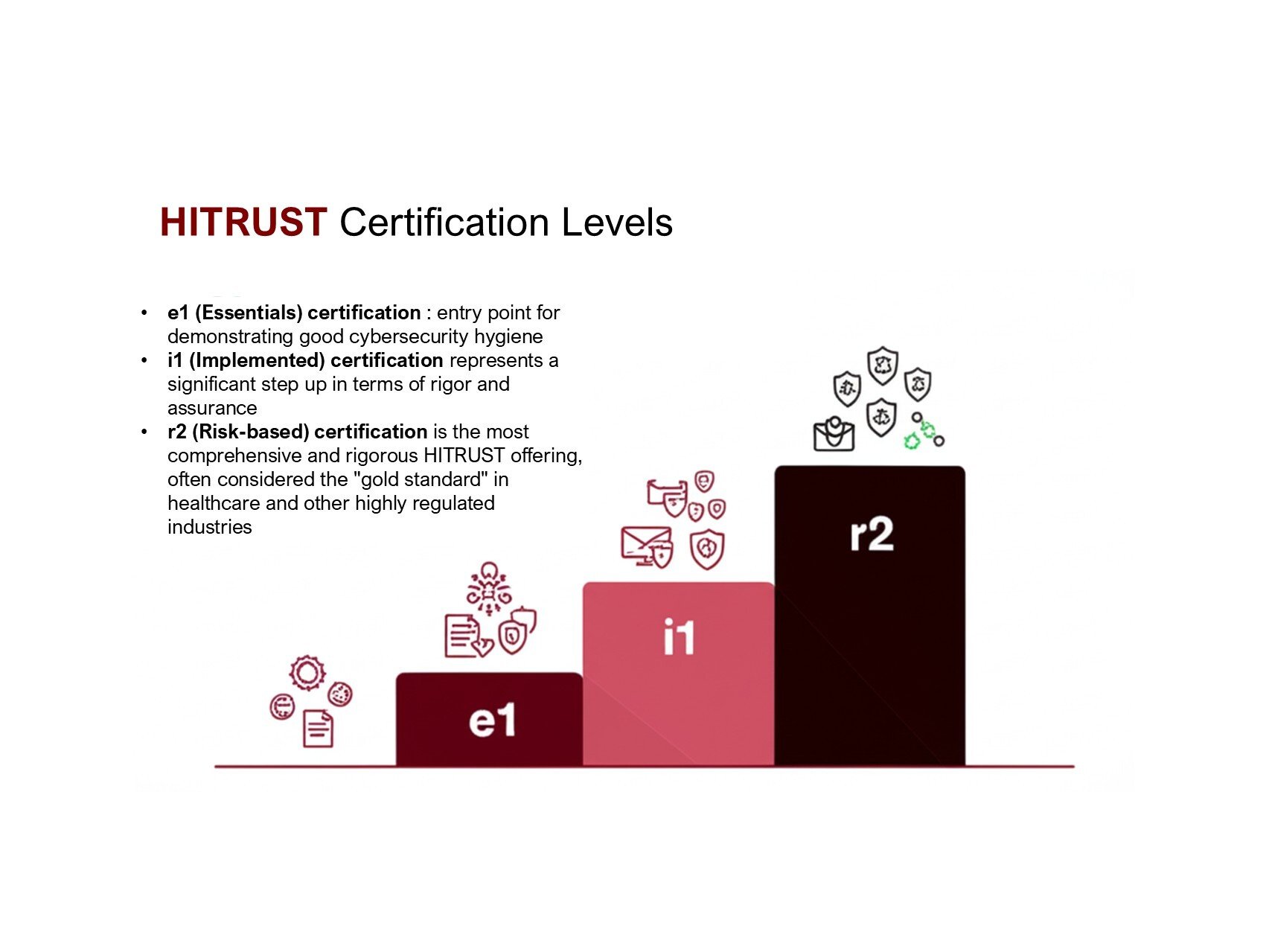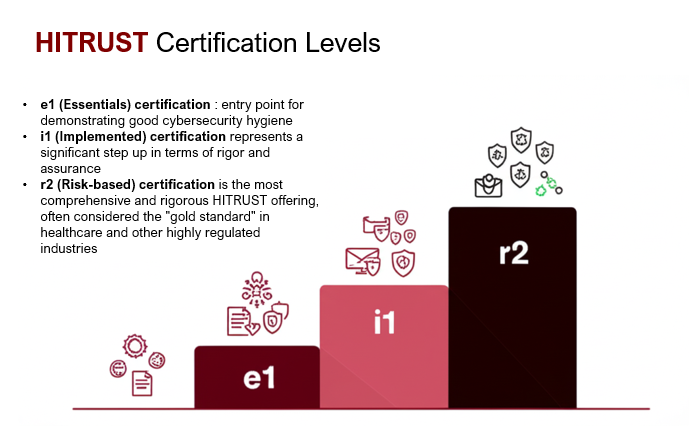Simplifying HITRUST e1 Certification: A Gateway to Enhanced Cybersecurity
In today's interconnected world, demonstrating robust cybersecurity and data protection is no longer optional—it's a fundamental requirement for...
6 min read
![]() Palindrome Technologies
:
May 20, 2025 10:37:40 PM
Palindrome Technologies
:
May 20, 2025 10:37:40 PM

As organizations increasingly handle sensitive data, demonstrating a strong commitment to security and compliance is no longer just a best practice, it's a business imperative. HITRUST certification has emerged as a gold standard for information protection, offering a framework that helps organizations of all sizes manage risk and safeguard data. But with different certification levels available, figuring out which one is more applicable and cost effective for your environment can feel overwhelming.
If you're looking to understand the nuances of HITRUST certification levels, their benefits, and how to choose the most appropriate one, you've come to the right place. Let's break down the HITRUST e1, i1, and r2 certifications to help you make an informed decision.

HITRUST offers a progressive portfolio of three core assessment and certification options, each designed to meet different organizational needs, risk profiles, and compliance objectives. A key advantage is that these levels are built upon the same HITRUST CSF (Cybersecurity Framework), meaning efforts invested in one level can often be leveraged for a more comprehensive one down the line.
Think of the e1 (Essentials) certification as the entry point for demonstrating good cybersecurity hygiene. It's an ideal starting place for organizations that are newer to formal security frameworks, have less complex IT environments, or lower risk profiles.
Benefits and Strengths of e1:
Is e1 Right for You?
The e1 certification is a strong contender if:
The i1 (Implemented) certification represents a significant step up in terms of rigor and assurance. It's designed for organizations that have more mature information security programs and are ready to demonstrate leading security practices against a broader array of cyber threats.
Benefits and Strengths of i1:
Is i1 Right for You?
The i1 certification might be the right fit if:
The r2 (Risk-based) certification is the most comprehensive and rigorous HITRUST offering, often considered the "gold standard" in healthcare and other highly regulated industries. It involves a tailored, risk-based approach to control selection, allowing organizations to demonstrate compliance with a wide array of regulatory requirements.
Benefits and Strengths of r2:
Is r2 Right for You?
The r2 certification is likely the most appropriate choice if:
| Feature | HITRUST e1 | HITRUST i1 | HITRUST r2 |
|---|---|---|---|
| Primary Goal | Foundational Cybersecurity | Leading Security Practices | Comprehensive, Risk-Based Security & Compliance |
| Assurance Level | Entry-level | Moderate | Highest |
| Number of Controls | ~44 (Predefined) | ~182+ (Predefined) | Dynamic (Selected from 2,000+ based on risk & regulatory factors) |
| Assessment Effort | Minimal | Moderate | High |
| Certification Term | 1 Year | 1 Year (Rapid Recertification option) | 2 Years (with Interim Review) |
| Scoping | Predefined | Predefined | Tailored |
| Ideal For | Startups, SMBs, low-risk profiles | Mid-sized orgs, maturing security programs | Large orgs, highly regulated industries, complex risk profiles |
| Key Strength | Quick, efficient, foundational validation | Threat-adaptive, robust security practices | Highest assurance, maps to multiple regulations, risk-based customization |
| Path Forward | Can build towards i1 or r2 | Can build towards r2 | Gold standard, maintains robust posture |
Choosing the right HITRUST certification level involves a careful assessment of your organization's:
Often, organizations may start with an e1 or i1 and progress to an r2 as their security program matures and business needs evolve. Consulting with a HITRUST Authorized External Assessor organization can also provide valuable guidance tailored to your specific circumstances.
| Fee Type | Description | Estimated Cost Range | Notes |
| HITRUST MyCSF Platform Access | Required SaaS platform for managing assessments, evidence, and corrective action plans. |
$3,000 - $6,000 (90-day assessment access) $15,000 - $50,000+ (Annual Corporate Subscription) |
A short-term license is often sufficient for a single assessment. Annual subscriptions offer continuous access and advanced features. |
| HITRUST Assessment Report Fee | Fee charged by HITRUST for the official validated assessment report and certification letter (if achieved). |
~$3,625+ (for validated assessment report) |
This is a direct fee to HITRUST for processing and issuing the report. |
| External Assessor Fees | Fees paid to a HITRUST-Authorized External Assessor (EA) firm for their services. This is often the largest cost. |
e1: $10,000 - $25,000+ i1: $25,000 - $70,000+ r2: $40,000 - $150,000+ (can be higher for very large/complex orgs) |
Varies greatly based on: - Assessment Type: e1 (Essentials, 44 controls), i1 (Implemented, 182 controls), r2 (Risk-based, 250-1800+ controls). - Organizational Size & Complexity - Scope of Assessment - Assessor Firm's Rates - Need for Readiness Assessment/Remediation Guidance |
| Internal Staff Time / Opportunity Cost | Time spent by your internal team on gathering evidence, documentation, remediation, project management, and coordinating with the assessor. | Highly Variable, often significant (Can equate to tens of thousands to hundreds of thousands in internal labor costs) |
This is an indirect but substantial cost. Organizations often underestimate the internal effort required. |
| Remediation Costs | Costs associated with implementing new controls, updating existing systems, purchasing new security tools, or making process changes to meet HITRUST requirements. | Highly Variable (from minimal to substantial) |
Depends entirely on your organization's current security maturity and the gaps identified during readiness. |
| Optional Consulting Fees | Engaging third-party consultants for pre-assessment readiness, gap analysis, policy development, or other advisory services. | Varies widely (can be a few thousand to tens of thousands, depending on scope) |
Many organizations opt for this to streamline the process and increase success rates. |
(*) Please always check with HITRUST for recent updates in fees
No matter which level you pursue, embarking on the HITRUST journey signifies a strong commitment to protecting sensitive information and building trust in an increasingly digital world. By understanding the distinct benefits and strengths of each certification level, you can strategically select the path that best aligns with your organization's security and compliance objectives.
In today's interconnected world, demonstrating robust cybersecurity and data protection is no longer optional—it's a fundamental requirement for...
In today's business landscape, Artificial Intelligence is no longer a futuristic concept but a powerful engine for innovation and efficiency. AI...
HITRUST CSF v11.5.0 Update: Key Changes and Strategic Benefits